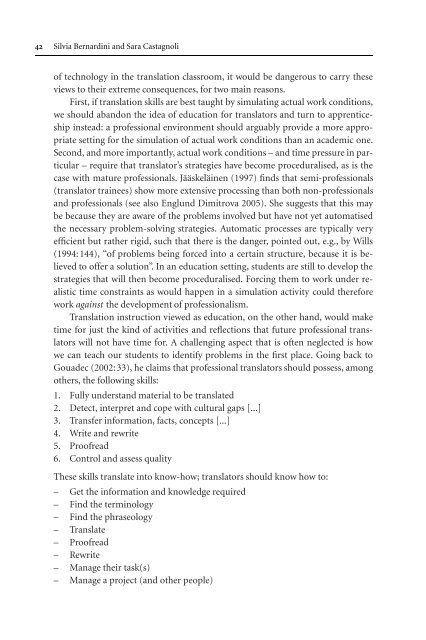Topics in Language Resources for Translation ... - ymerleksi - home
Topics in Language Resources for Translation ... - ymerleksi - home
Topics in Language Resources for Translation ... - ymerleksi - home
- No tags were found...
Create successful ePaper yourself
Turn your PDF publications into a flip-book with our unique Google optimized e-Paper software.
42 Silvia Bernard<strong>in</strong>i and Sara Castagnoliof technology <strong>in</strong> the translation classroom, it would be dangerous to carry theseviews to their extreme consequences, <strong>for</strong> two ma<strong>in</strong> reasons.First, if translation skills are best taught by simulat<strong>in</strong>g actual work conditions,we should abandon the idea of education <strong>for</strong> translators and turn to apprenticeship<strong>in</strong>stead: a professional environment should arguably provide a more appropriatesett<strong>in</strong>g <strong>for</strong> the simulation of actual work conditions than an academic one.Second, and more importantly, actual work conditions – and time pressure <strong>in</strong> particular– require that translator’s strategies have become proceduralised, as is thecase with mature professionals. Jääskelä<strong>in</strong>en (1997) f<strong>in</strong>ds that semi-professionals(translator tra<strong>in</strong>ees) show more extensive process<strong>in</strong>g than both non-professionalsand professionals (see also Englund Dimitrova 2005). She suggests that this maybe because they are aware of the problems <strong>in</strong>volved but have not yet automatisedthe necessary problem-solv<strong>in</strong>g strategies. Automatic processes are typically veryefficient but rather rigid, such that there is the danger, po<strong>in</strong>ted out, e.g., by Wills(1994:144), “of problems be<strong>in</strong>g <strong>for</strong>ced <strong>in</strong>to a certa<strong>in</strong> structure, because it is believedto offer a solution”. In an education sett<strong>in</strong>g, students are still to develop thestrategies that will then become proceduralised. Forc<strong>in</strong>g them to work under realistictime constra<strong>in</strong>ts as would happen <strong>in</strong> a simulation activity could there<strong>for</strong>ework aga<strong>in</strong>st the development of professionalism.<strong>Translation</strong> <strong>in</strong>struction viewed as education, on the other hand, would maketime <strong>for</strong> just the k<strong>in</strong>d of activities and reflections that future professional translatorswill not have time <strong>for</strong>. A challeng<strong>in</strong>g aspect that is often neglected is howwe can teach our students to identify problems <strong>in</strong> the first place. Go<strong>in</strong>g back toGouadec (2002:33), he claims that professional translators should possess, amongothers, the follow<strong>in</strong>g skills:1. Fully understand material to be translated2. Detect, <strong>in</strong>terpret and cope with cultural gaps [...]3. Transfer <strong>in</strong><strong>for</strong>mation, facts, concepts [...]4. Write and rewrite5. Proofread6. Control and assess qualityThese skills translate <strong>in</strong>to know-how; translators should know how to:– Get the <strong>in</strong><strong>for</strong>mation and knowledge required– F<strong>in</strong>d the term<strong>in</strong>ology– F<strong>in</strong>d the phraseology– Translate– Proofread– Rewrite– Manage their task(s)– Manage a project (and other people)
















